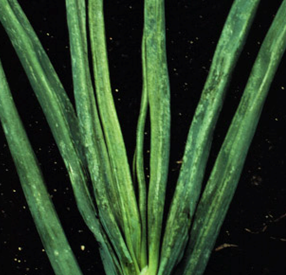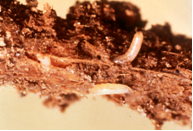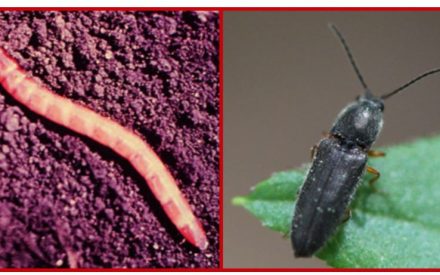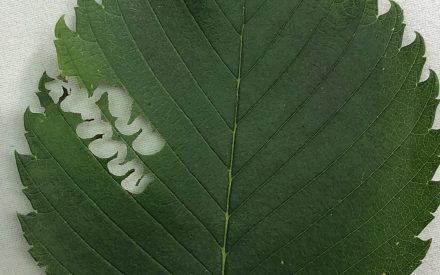
Karen Delahaut, formerly UW-Madison Fresh Market Vegetable Program
Revised: 1/9/2005
Item number: XHT1133
Onion maggots (Hylemya antiqua) are a common and often serious insect pest of plants in the onion family including onion (where they can be the most serious production problem), leeks, shallots, garlic, and chives. Onion maggots feed below ground on host bulbs, producing tunnels and damaging bulb tissue. Onion maggots are also thought to introduce disease-causing organisms into plants. Onion maggots are typically more of a problem where onions are grown year after year in the same location.
Appearance: Adult onion maggots are slender, grey, large-winged, bristly flies that resemble houseflies, but are only 1/4 inch long. Their wings are held overlapped over their bodies while at rest. Eggs are elongated and white and are laid at the base of the plant. There are three cream-colored larval stages called maggots that develop over the course of two to three weeks.
Symptoms and Effects: Onion maggot larvae feed on the below-ground hypocotyl tissue of seedlings, resulting in a variety of damage symptoms. Larval feeding may kill seedlings and therefore, poor plant stands may indicate an onion maggot problem. In larger plants, larvae may tunnel into the bulb leading to flaccid and yellow plants. Onion maggot feeding can introduce the soft rot bacterium (Erwinia carotovora) into the plant.
Life Cycle: Onion maggots overwinter as pupae in the soil associated with culled onions in the field, or onion cull piles. Adults emerge around mid-May and mate over a three day period after which they begin laying tiny, white eggs at the base of host plants. The larvae, upon emergence, crawl beneath the leaf sheath and enter the bulb. The onion maggot pupates in the soil and a second generation of adults appears three to four weeks later. In total, onion maggots have three generations per year. The first generation is often the largest and the most damaging. The third generation attacks onions in mid-August shortly before harvest. Feeding damage at this time can lead to storage rots as onion maggots introduce bacteria into feeding wounds. Cool, wet weather favors the development of onion maggots, while hot, dry weather is detrimental to the survival of this pest.
Scouting Suggestions: Once damage has been detected, control actions will no longer be effective. Therefore, action thresholds for foliar insecticide applications are based on adult onion maggot emergence. Peak emergence of each generation can be forecasted using degree day accumulations. Begin accumulating degree days when the ground thaws in the spring. A base temperature of 40°F should be used. The first three generations of onion maggots will occur when totals of 680 degree days 40 (spring), 1950 degree days 40 (summer), and 3230 degree days 40 (fall) respectively, have been reached.
Control
Cultural: Effective onion maggot control programs should include the following elements to reduce populations, avoid insecticide resistance, and achieve control. Onion crops should be rotated whenever possible to provide at least 1/2 mile between new seedings and previous crops or cull piles. This may not always be possible on smaller farms. Overwintering populations of onion maggots can be reduced through the destruction of crop debris and removal of culls from the field. Onion sets should be planted one week before fly emergence is predicted.
Chemical: Preventative soil insecticide applications are recommended for the control of first generation larvae if damage from the previous year’s crop exceeds 5 to 10%. Foliar insecticide applications should be avoided since they are generally ineffective on adult populations that move in and out of fields. Resistance has been documented in onion maggots and therefore, pesticides must be selected which do not exacerbate insecticide resistance. For a list of registered insecticides, consult UWEX publication Commercial Vegetable Production in Wisconsin (2024).
Download Article





 Onion Thrips
Onion Thrips Degree Days for Common Fruit & Vegetable Insect Pests
Degree Days for Common Fruit & Vegetable Insect Pests Wireworms
Wireworms Elm Zigzag Sawfly
Elm Zigzag Sawfly


